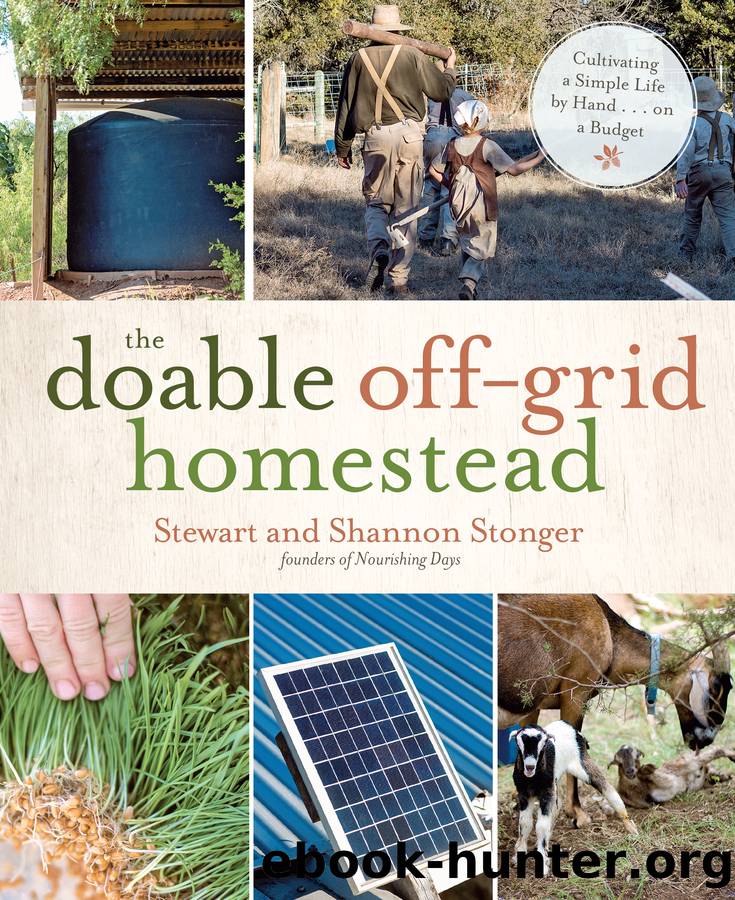The Doable Off-Grid Homestead by Shannon Stonger

Author:Shannon Stonger [Stonger, Shannon]
Language: eng
Format: epub
Publisher: Page Street Publishing
Published: 2018-05-30T00:00:00+00:00
Hardworking Annuals
When your soil, water or climateâor all threeâprovide ample challenges, finding reliable, tough vegetable varieties is critical. The following are some of our favorite heat-, drought- and poor soilâtolerant garden vegetable varieties:
⢠Armenian cucumbers. This cucumber produces extremely large and tasty cucumber fruits. It has shown itself to be incredibly productive even in drought conditions.
⢠Austrian winter peas. This plant is a cold-tolerant winter pea that you can use as a cover crop. In some places, it will die in the winter; in other places, it may grow right through winter. You can also eat the pea shoots and put them in salads.
⢠Blue speckled tepary beans. This variety is a great heat- and drought-tolerant bean to use as a cover crop in between plantings of other things. You can also eat them, but it takes a lot of the little beans to amount to much. This bean can reseed itself sometimes and give you some nice volunteer plants.
⢠Desi summer squash. Summer squash and zucchini are one of the easiest of all vegetables to grow. This is such a fast-growing variety that you can stagger planting for several seasonsâ worth of harvests.
⢠Garlic. Garlic is incredibly easy to grow and one of the first plants you can probably grow enough of to provide yourself with a year-round supply. Also, it is just plain good for you. Eat more garlic!
⢠Hopi pale grey squash. This is a winter squash variety that seems to tolerate the heat well. It is supposed to store for a very long period of time.
⢠Red Ripper cowpeas. These are a large cowpea variety. They also have great flavor.
⢠Seminole pumpkin. This is a fast-growing and productive pumpkin that perked up and produced like crazy every time it rained.
⢠Sodbuster radishes. These are a great cover crop for breaking up soil and adding organic material. The Sodbusterâs taproot is supposed to be able to go up to 6 feet (1.9 cm) deep. The actual radish part can punch a hole 10 to 20 inches (25 to 50 cm) deep!
⢠Sunn hemp. Sunn hemp should not to be confused with hemp. It is a great nitrogen-fixing cover crop that can also be used as goat feed.
⢠Sweet potatoes. Sweet potatoes make great ground cover, and you can eat the greens in salads. They may be a perennial for you if you live far enough south.
⢠Turnips. These roots really do seem to grow in the worst soil, the worst drought and the worst overall conditions. The greens are especially well-loved by cows and goats.
⢠Kazakh melons. Grown right through high summer, this drought-tolerant melon sprawls wide to produce small, very sweet and juicy yellow cantaloupes.
⢠Pigeon peas. Virtually unknown in the United States, pigeon peas are heat- and drought-tolerant. Look for shorter-season varieties unless you are just growing them for organic material.
Download
This site does not store any files on its server. We only index and link to content provided by other sites. Please contact the content providers to delete copyright contents if any and email us, we'll remove relevant links or contents immediately.
The Well Plated Cookbook by Erin Clarke(769)
The Chicken Bible by America's Test Kitchen(766)
Tiny Houses: The Perfect Tiny House, With Tiny House Example Plans (Tiny Houses, Tiny House Living, Tiny Homes, Tiny Home living, Small Home, Small Houses, Tiny House Plans, Small House Plans Book 1) by Christopher Dillashaw(664)
Pinch of Nom Quick & Easy by Kay Featherstone & Kay Featherstone(650)
Beginners by Tom Vanderbilt(629)
Wheat Belly by MD William Davis(624)
The Little Book of Life Skills: Deal With Dinner, Manage Your Email, Make a Graceful Exit, and 152 Other Expert Tricks by Erin Zammett Ruddy(579)
The Mindful Glow Cookbook: Radiant Recipes for Being the Healthiest, Happiest You by Abbey Sharp(578)
Quick and Delicious by Gordon Ramsay(575)
Happy Inside by Michelle Ogundehin(569)
A Year at the Chateau by Dick Strawbridge & Angel Strawbridge(563)
101 Chillies to Try Before You Die (101 to Try Before You Die) by David Floyd(557)
To Asia, With Love by Hetty McKinnon(553)
101 Ways To Go Zero Waste by Kathryn Kellogg(534)
Living by the Code by 2021(521)
Reader's Digest Home Hacks by Reader's Digest(513)
Advanced Automotive Fault Diagnosis by Denton Tom;(505)
Skinnytaste Meal Prep by Gina Homolka(494)
Practical Hints on Camping by Howard Henderson(475)
